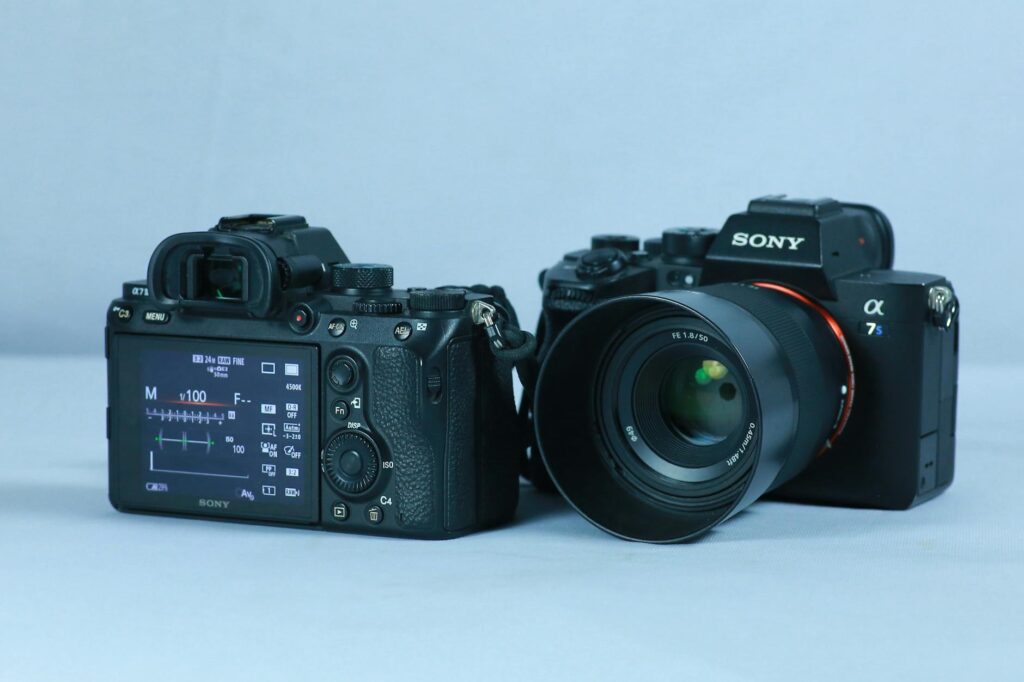Introduction
camera brands 📸 In a world where everyone claims to be a photographer, choosing the right camera brand can feel like navigating through a maze of technical jargon and conflicting opinions. With industry giants like Canon, Nikon, and Sony dominating the market, and innovative newcomers disrupting traditional photography, making the right choice has never been more challenging.

Top Camera Brands in the Market
Canon’s Professional Legacy
Canon has maintained its position as a market leader through decades of innovation and reliability. Their EOS line has become synonymous with professional photography, particularly in sports and photojournalism.
Nikon’s Innovation Edge
Nikon’s commitment to optical excellence and cutting-edge technology has earned them a devoted following. Their Z-series mirrorless cameras represent their latest innovation leap, while their F-mount DSLR system remains a industry standard.
Sony’s Mirrorless Revolution
Sony revolutionized the camera industry with their Alpha series mirrorless cameras. Their technological prowess in sensor development and autofocus capabilities has set new benchmarks in the industry.
Fujifilm’s Retro Appeal
Fujifilm combines classic design aesthetics with modern technology, appealing to both vintage enthusiasts and contemporary photographers.
Key Features Comparison:
| Brand | Known For | Best Use Case | Price Range |
|---|---|---|---|
| Canon | Reliability | Professional/Sports | $500-$6000 |
| Nikon | Optical Quality | Wildlife/Landscape | $500-$5500 |
| Sony | Innovation | Video/Hybrid | $700-$6500 |
| Fujifilm | Color Science | Street/Portrait | $500-$4000 |
Top strengths of each brand:
- Canon: Extensive lens ecosystem and superior autofocus
- Nikon: Weather sealing and dynamic range
- Sony: Compact form factor and eye-tracking AF
- Fujifilm: Film simulations and intuitive controls
Choosing the Right Brand for Your Needs
Budget Considerations
When selecting a camera brand, your budget plays a crucial role in determining your options. Here’s a breakdown of typical price ranges across major brands:
| Brand Tier | Price Range | Notable Brands |
|---|---|---|
| Entry-level | $400-800 | Canon Rebel, Nikon D3000 series |
| Mid-range | $800-2000 | Sony a6000 series, Fujifilm X-T |
| Professional | $2000+ | Canon R, Nikon Z, Sony A7 |
Photography Style Match
Different brands excel in specific photography styles:
- Portrait Photography
- Canon: Superior skin tones
- Sony: Excellent eye-tracking AF
- Landscape Photography
- Nikon: Outstanding dynamic range
- Fujifilm: Rich color science
- Action/Sports
- Sony: Best-in-class autofocus
- Canon: Robust weather sealing
Lens Ecosystem
Consider these factors when evaluating lens systems:
- Native lens selection
- Third-party compatibility
- Second-hand market availability
- Upgrade path within the brand
Each major brand offers distinct advantages. Canon and Nikon boast extensive lens collections built over decades, while Sony has rapidly developed a comprehensive modern lineup. Fujifilm provides exceptional quality within a smaller ecosystem, particularly suited for enthusiast photographers. camera brands.
Your photography goals and shooting style should guide your choice. A wedding photographer might benefit from Canon’s dual-pixel AF and skin tones, while a wildlife photographer could prefer Sony’s tracking capabilities. camera brands.
Camera Brand Specializations
Sports Photography Leaders
- Canon and Nikon dominate the sports photography realm
- Key features: fast autofocus, high burst rates, superior tracking
- Professional choices: Canon 1DX series, Nikon D6
Portrait Photography Excellence
- Sony and Fujifilm lead in skin tone reproduction
- Features: eye-tracking AF, natural color science
- Popular choices: Sony A7 series, Fujifilm GFX line
Landscape Photography Experts
- Pentax and Sony excel in weather sealing and dynamic range
- Notable features: pixel shift, in-body stabilization
- Top picks: Pentax K-1, Sony A7R series
| Brand Specialty | Key Models | Notable Features |
|---|---|---|
| Sports | Canon 1DX III, Nikon D6 | 14-20 fps, Dual CFexpress |
| Portrait | Sony A7 IV, Fujifilm GFX100S | Eye AF, Medium Format |
| Landscape | Pentax K-1 II, Sony A7R V | Weather Sealed, High MP |
| Video | Panasonic S1H, Sony FX3 | 6K Recording, Dual ISO |
| Street | Fujifilm X100V, Leica Q2 | Compact, Silent Operation |
Video Production Champions
- Panasonic and Sony lead videography innovation
- Features: 10-bit recording, advanced codecs, cooling systems
- Professional choices: Panasonic S1H, Sony FX line
Street Photography Favorites
- Fujifilm and Leica dominate street photography
- Key aspects: compact design, discrete operation
- Popular models: X100 series, Leica M series
Investment Value
Resale Potential
Different camera brands hold their value differently in the secondary market. Canon and Nikon consistently maintain strong resale values, typically retaining 50-70% of their original price after 3-5 years. Leica leads the pack with exceptional value retention, often maintaining up to 80-90% of its initial value. camera brands
| Brand | Average Value Retention (3 years) |
|---|---|
| Leica | 80-90% |
| Sony | 60-75% |
| Canon | 55-70% |
| Nikon | 50-65% |
| Fuji | 45-60% |
Durability Rankings
Professional-grade cameras are built to last, with varying levels of weather sealing and build quality:
- Top Tier (Excellent Build Quality)
- Canon 1D series
- Nikon D6/Z9
- Sony A1
- Mid Tier (Good Build Quality)
- Canon 5D/R series
- Nikon D850/Z6
- Sony A7 series
Repair Service Quality
Manufacturer service networks vary significantly in quality and accessibility. Canon and Nikon maintain extensive service networks with quick turnaround times averaging 1-2 weeks. Sony has improved its service infrastructure, though coverage may be limited in some regions. Premium brands like Leica offer white-glove service but at premium prices and potentially longer wait times. camera brands
Future of Camera Brands
Technological Innovations
The camera industry is witnessing revolutionary advancements in AI-powered autofocus, computational photography, and 8K video capabilities. Major brands are incorporating machine learning algorithms to enhance image quality and shooting experience. camera brands
Market Trends
- Mirrorless dominance continues to grow
- Increased focus on content creator-specific features
- Emphasis on wireless connectivity
- Rise of hybrid shooting capabilities
Emerging Competitors
New players are disrupting the traditional camera market, particularly from Asia. Here’s how the landscape is changing:
| Brand Type | Market Impact | Key Features |
|---|---|---|
| Traditional | Maintaining premium segment | Professional features |
| New Entries | Targeting mid-range | Innovation-focused |
| Smartphone | Growing influence | Computational photography |
Smartphone Integration
Camera manufacturers are adapting to smartphone dominance by developing companion apps and wireless features. Brands are focusing on seamless integration between dedicated cameras and mobile devices, offering instant sharing capabilities and remote control functions. camera brands
Conclusion
Photography enthusiasts today have access to an impressive array of camera brands, each offering unique strengths and specializations. From Canon’s versatile lineup to Sony’s cutting-edge mirrorless technology, and from Nikon’s professional-grade equipment to Fujifilm’s retro-inspired designs, there’s a perfect camera brand for every type of photographer. Understanding these brands’ specialties and matching them with your specific needs and budget is crucial for making a worthwhile investment. camera brands







3 Comments
Pingback: Internet Chicks: 1 Comprehensive Guide to Building Connections and Empowering Women Online - technewweb.com
Pingback: sheppard software: Empowering Minds, 1k Inspiring Learning - techhubs.co.uk
Pingback: Lifestyle Brands f0r a Digital World: Trends to Embrace - topixhubinfo